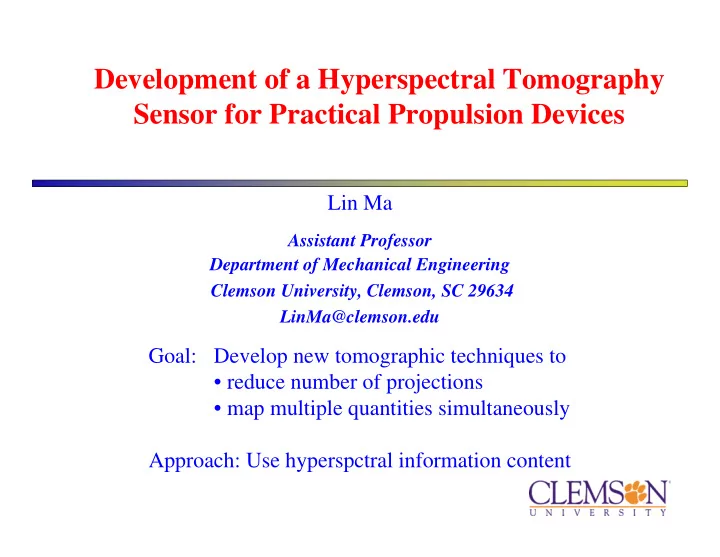

Development of a Hyperspectral Tomography Sensor for Practical Propulsion Devices Lin Ma Assistant Professor Department of Mechanical Engineering Clemson University, Clemson, SC 29634 LinMa@clemson.edu Goal: Develop new tomographic techniques to • reduce number of projections • map multiple quantities simultaneously Approach: Use hyperspctral information content
Background – Tomography • Tomography: Imaging by line-of-sight-averaged projections • A mature technique in many areas (medicine, archeology, etc) Hyperspectral Tomography 2
Background – Limitations Limitations of traditional tomographic technique • Too many projections e.g. 10x10 grid � 100 unknowns � 100+ equations � 100+ projections • Impractical in many areas where temporal resolution/cost is a concern Engine monitoring, combustion control, etc Our approach – Add wavelengths to reduce the number of projections (hyperspectral absorption spectroscopy) The 10x10 example again: if each projection contains 5 wavelengths � 100 equations to solve for 100 unknowns � 20 projections � A fivefold reduction of projections compared with single- λ technique Facilitated by wavelength-multiplexing technologies and new broadband laser sources Hyperspectral Tomography 3
Background Tomographic Inversion Algorithm Existing algorithms cannot be directly applied to: • Incorporate multiple wavelengths, i.e. effectively exploited the multispectral information content • Address the highly nonlinear nature of absorption spectroscopy 2 hc − − 1 exp( ) λ ( ) '' 1 1 Q T hcE kT λ = λ ⋅ ⋅ − ⋅ − ⋅ i ( , ) ( , ) exp[ ( )] S T S T 0 i i 2 ( ) Q T k T T hc − − 0 0 1 exp( ) λ kT 0 i Our approach: • Formulate the problem into a minimization problem • Solve the minimization problem by a robust global algorithm • Flexibly utilize a priori information to regulate the minimization problem Hyperspectral Tomography 4
Summary Hyperspectral Absorption Tomography • Absorption Spectroscopy ∫ b λ = λ ⋅ ⋅ ( , ) [ ( , ), ] ( , ) p L P S T x y X x y dl j i i a T(x,y) and X(x,y) are the temperature and concentration distributions to be imaged L j the jth projection location λ i the ith wavelength • The minimization formulation J I ∑ ∑ = λ − λ 2 ( , ) [ ( , ) ( , )] D T X p L p L m j i c j i = = 1 1 j i D reaches its minimal (zero) when T and X matches the true distribution. • The incorporation of regularization ( a priori constraints) = + γ ⋅ + γ ⋅ ( , ) ( , ) ( ) ( ) F T X DT X R T R X T T X X Hyperspectral Tomography 5
Sample Phantoms The T and X phantoms Simulation conditions: 10x10 grid 10 wavelengths 20 projections Phantoms created to simulate the multimodal T and X distributions in practice Hyperspectral Tomography 6
A Difficult Minimization Problem F is a complicated function (multiple local minima with similar amplitudes) and is difficult to minimize. An advanced minimization algorithm (simulated annealing) overcomes this difficulty. Hyperspectral Tomography 7
Background Simulated Annealing and Regularization • Simulated Annealing (SA) 1. A statistical minimization method 2. Simulates how solids anneal 3. A non-greedy method and a global method • Regularization = + γ ⋅ + γ ⋅ ( , ) ( , ) ( ) ( ) F T X D T X R T R X T T X X 1. R T and R X contains the a priori information, i.e., smoothness, bounds, boundary conditions, etc. 2. Determination of optimal γ T and γ C not trivial in nonlinear problems 3. Details see our papers Numerical investigation of hyperspectral tomography for simultaneous temperature and concentration imaging , Applied Optics, v47, Issue 21, pp.3751, 2008. Determine the optimal regularization parameters in hyperspectral tomography , Applied Optics, in press. Hyperspectral Tomography
Sample Reconstruction Results The reconstructed T and X distributions The reconstruction errors • Excellent imaging fidelity with significantly fewer projections Hyperspectral Tomography 9
A Typical Minimization Process M N ∑∑ − rec | | T T , , m n m n = = = 1 1 m n e T M N ∑∑ | | T , m n = = 1 1 m n M N ∑∑ − rec | | X X , , m n m n = = = 1 1 m n e X M N ∑∑ | | X m , n = = 1 1 m n γ T = 1×10 -10 and γ x = 1×10 -2 • e T and e x characterize the overall reconstruction quality • The Simulated Annealing technique provides robust and effective solution to the problem Hyperspectral Tomography 10
A Closer Look at the Reconstruction 2000 1900 1800 T (K) 1700 Phantoms Reconstructions 1600 Reconstructions with 0.5% noise in projections 0.09 X 0.08 Comparison between phantoms and reconstructions along the 4th column (n=4) 0.07 1 2 3 4 5 6 7 8 9 10 m • The reconstruction quality remains good with error in the projections Hyperspectral Tomography 11
Hyperspectral Tomography Enhances Reconstruction Stability 2 ‐ Wavelength Hyperspectral 100 projections 20 projections, 10 wavelengths Simulation Conditions 10x10 grid 0.5% random noise in projections • 2-wavelength unable to maintain good sensitivity when temperature non-uniformity is prominent � reconstruction sensitive to noise • Hyperspectral information content ameliorates this problem Hyperspectral Tomography 12
Technique Insensitive to Measurement Noise • Technique stable in the presence of measurement error. • Superior stability over single- or two-wavelength tomography techniques • Ongoing investigation to improve X measurements Hyperspectral Tomography 13
Conclusions A tomographic imaging technique has been developed to • Exploit the hyperspectral information content enabled by broadband lasers • Provide simultaneous imaging of temperature and chemical species concentration • Reduce the number of projections significantly • Enhance the reconstruction stability against measurement uncertainty Experimental demonstration underway. Hyperspectral Tomography 14
Recommend
More recommend